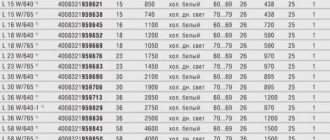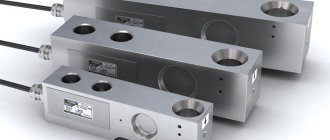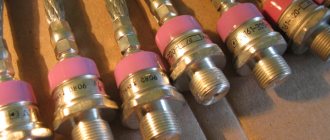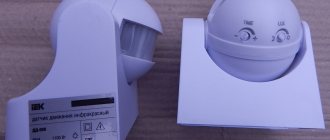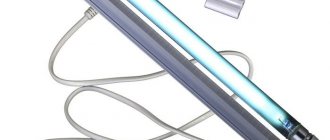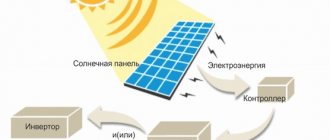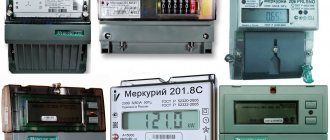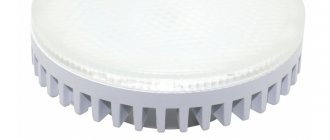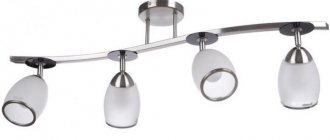The DRL lamp, which remains popular, is a representative of gas-discharge lighting devices, characterized by a rich luminous flux and durability. Products containing mercury have proven themselves in the installation of artificial lighting of streets and industrial facilities.
However, a number of technical and operational nuances prevent them from being used in everyday life and cast doubt on their appropriateness for use in other areas of life. You will learn everything about high-pressure gas-discharge lighting devices from our article. Our tips will help you choose the right devices.
Design features
What are DRL 250 lamps made of? Their characteristics include the presence of the following components:
- Nickel plated base.
- A resistor that provides voltage limiting.
- Molybdenum foils.
- Framework.
- Glass flask (the luminomorphic coating is actually applied to it).
- Lead wire.
- Tungsten coated main electrode.
- Nitrogen, which acts as a filler for the outer flask.
- Compressed junction of a quartz light source. The quartz burner is the main working element of the lamp.
By the way, the first models of the lamps described had only two electrodes. However, such a device significantly worsened the process of turning on and warming up the lighting point, as a result of which the presence of an additional starting element called a high-voltage pulse-type breakdown of the burner gap was required. This version of the lamp was very quickly recognized as ineffective and was replaced with a four-electrode version equipped with a choke, without which the operation of such a lamp is simply physically impossible - it will simply burn out the moment it is turned on.
How it works?
The working process of DRL 250 lamps, the characteristics of which are ideal for use in industrial premises, comes down to the following points.
After the supply voltage is applied, it bypasses the base and flows to the electrodes, and this, in turn, ensures the occurrence of a glow discharge. As a result, free electrons and positive ions are formed in the flask. After some time, when the number of charge carriers reaches a certain critical point, the glow discharge transforms into an arc discharge. Often, from the moment of switching on to the occurrence of a stable arc discharge occurs within one minute. It is worth noting that the distance between the electrodes is very small, so gas ionization in this gap occurs quite easily.
What it is
The names of lamps usually indicate the type of light source. A specialist who understands labeling will quickly determine the parameters and operating principle of the device.
The decoding of the DRL is as follows:
- D - the electric arc formed when voltage is applied to the contacts leads to the ignition of the lamp. The design involves a choke, the task of which is to limit operating currents within specified limits;
- P - the device operates using mercury vapor;
- L - operating principle of the light source. The phosphor, which provides the luminescence process, converts ultraviolet light into the visible spectrum of radiation.
This is what the product looks like.
Additional information! When external energy is applied to a material, the light emitted begins a glowing process called luminescence.
The variety closest to DRL is DRV (mercury-tungsten). They are similar in design and principle of operation. Only in addition to the mercury discharge torch, a tungsten spiral is also installed, the task of which is to limit the strength of the current supplied to the burner. Accordingly, such lamps do not require additional ballasts.
Unlike DRL, DVR lamps:
- consume more electricity;
- work for approximately 3000 hours;
- light up for no longer than one minute.
Other “close” types are DRI and HPS bulbs.
Size depends on power characteristics
Warm-up time
DRL 250 lamps begin to burn as much as possible (the characteristics of the devices will be indicated below) approximately 7-10 minutes after they are put into operation. It takes so much time because mercury in an unheated state, located in a quartz burner, is presented in the form of droplets or a thin layer on the walls of the glass flask. But after turning on the lamp, high temperature begins to act on this liquid metal, and this in turn leads to the evaporation of mercury and a gradual improvement in the discharge between the existing electrodes. At the moment when all the mercury is completely converted into gaseous form, the DRL lamp will begin to operate in its nominal mode.
Life time
The service life of DRL lamps directly depends on the power. The most common DRL 250 can operate for about 12,000 hours without any problems. It is important to remember that the following factors can reduce the resource:
- frequent switching on and off;
- voltage fluctuations;
- continuous use at low ambient temperatures.
All this leads to accelerated degradation of the electrodes and, as a consequence, rapid failure.
Disposal
The presence of mercury in DRLs places them in the first hazard class. In a number of countries, such devices are prohibited for use. However, compliance with the rules of operation and disposal minimizes all risks to humans and the environment.
DRL disposal area
It is prohibited to throw away such lighting sources with regular garbage. Mercury released into the environment can significantly harm the environment.
Disposal of DRLs is carried out by the same structures that work with other energy-saving lamps. The company must have a state license authorizing such work.
In large cities you can find special tanks in which spent elements are placed. You can also contact utility companies, lighting equipment manufacturers or repair companies, or hazardous waste disposal companies.
Features of operation
An important nuance that users should know: after turning off the DRL 250 lamp (its characteristics and luminous flux are given in the table), it will be impossible to turn it on until it has completely cooled down. In addition, the lighting device in question is extremely sensitive to temperature. In this regard, its operation without the presence of an external glass flask is simply physically impossible. This flask performs two important functions:
- Acts as a barrier between the burner and the external environment.
- Provides assistance to the phosphor located on its inner walls in converting ultraviolet light into the red spectrum. In combination with the green color emitted from the internal discharge, white light is obtained, which is ultimately emitted by the lamp itself.
Remember that voltage fluctuations in the electrical network cause similar fluctuations in the luminous flux of the lamp. The voltage deviation, which is considered acceptable, is considered to be within 10-15% of the nominal value. If this figure is 25-30%, then the lamp will work unevenly. When the voltage drops to 80% of the required value, the lamp either will not light up at all, or will go out if it was in operation.
Marking
In domestic practice, the number following the DRL means power consumption in W. Next comes the red ratio: the ratio of the red flux (from 600 to 780 nm) to the total - expressed as a percentage. The development number is separated by a hyphen. The red ratio characterizes color rendering; values above ten are considered good.
According to the international standard IEC 1231, the ILCOS system is used. These are competitors of the German LBS marking and the pan-European ZVEI. There is complete chaos in the market. According to ILCOS:
- QE stands for ellipsoidal bulb shape.
- QR denotes a bulb with an internal reflective layer, mushroom-shaped.
- QG stands for spherical flask.
- QB stands for products with built-in ballast.
- QBR stands for products with built-in ballast and reflective layer.
Philips has its own view of things, but General Electric doesn’t want to hear about either. Actually, it is better to rely on reference books or read the information on the packaging. Remember that the base comes in standard sizes and in other sizes. The share of DRL lamp production is continuously decreasing, so there is no point in studying complex designations in too much detail. And given the entry of LEDs into the market, it is better to find something modern and constantly evolving for your home and garden. As for efficiency, the dispute will clearly not be resolved in favor of discharge lamps, although for some time they successfully deposited the filament.
A few words about the throttle
The characteristics of the DRL 250 choke are such that it is used to limit the current supplying the lamp itself. You should understand that if you turn it on without a choke, it will burn out instantly because too much electric current will pass through it. Experts say that a capacitor should also be introduced into the lamp connection circuit, but not of the electrolytic type. Its presence will make it possible to influence reactive power, and this in turn will lead to almost double energy savings.
Application area
DRL lighting devices are actively used as a source of artificial light in external and internal lighting: for illuminating roadways, highways, parks and squares, as well as production facilities and industrial workshops with a power of several megawatts.
DVR products are used in the same facilities as DRL, as well as in lighting agricultural enterprises that grow various crops in insulated soil. These can be greenhouses, greenhouses, gardens.
Indicators of DRL lamps
| Name | Operating voltage, V | Power, W | Length, mm | Diameter, mm | Base type | Luminous flux, lm | Service life, hours |
| DRL 125 | 125 | 125 | 178 | 76 | E 27 | 5900 | 12000 |
| DRL 250 | 130 | 250 | 228 | 91 | E 40 | 13500 | 15000 |
| DRL 400 | 135 | 400 | 292 | 122 | E 40 | 24000 | 18000 |
| DRL 700 | 140 | 700 | 357 | 152 | E 40 | 41000 | 20000 |
| DRL 1000 | 145 | 1000 | 411 | 167 | E 40 | 59000 | 18000 |
Advantages and negative qualities
What is good and what is bad about DRL 250 lamps? The characteristics of their development provide them with the following positive indicators:
- Very high light output compared to other lighting devices.
- No dependence on precipitation.
- An impressive service life, which can easily reach 20 thousand hours.
- The emission spectrum is very close to natural light.
- Small own dimensions.
The disadvantages of lamps are:
- Formation of ozone during operation.
- Quite a high price (such lamps are 5–7 times more expensive than a regular incandescent lamp).
- In some cases, tungsten analogues will have smaller dimensions than DRL.
- After several months of operation, the emitted light spectrum changes as the technical characteristics of the phosphor layer change.
- The presence of mercury forces users to dispose of lamps according to a special scheme, separately from other goods, things, and products.
- Switching on occurs with some delay, and it takes several minutes to achieve combustion at full power.
- The light from such lamps is of rather low quality.
- Very high flicker factor during operation.
- It is best to hang lamps at a height of at least four meters.
- Towards the end of its service life, the luminous flux of the device decreases significantly.
- The lamp can only operate on alternating current.
Installation
PRA
To create high-quality lighting using DRL lamps (power 250 or 400 W), you must install this product correctly. After all, even high-quality products will not last long if installed incorrectly. Especially if the lamp was installed outdoors. The majority of types of DRL lamps are connected to the network through ballasts.
When installing DRL type lamps (power 250 or 400 W), the following rules should be observed:
- Before installation, you need to de-energize the part of the house in which such a lamp will be installed;
- Installation of electrical wiring is carried out in an open design. The wires are attached to insulators, busbars or ART wires;
- To install the lamp, you need to use the complete mounting elements that are sold along with the product;
- Be sure to follow the recommendations given in the manufacturer's instructions. Otherwise, after installation, the DRL-type lighting device may begin to work incorrectly;
- the connection of the wires coming from the lamp to the electrical network should be done strictly according to the diagram;
Connection diagram
- All wire contact points should be well insulated from moisture. Moisture getting inside the device can lead to a short circuit, which will negatively affect its functionality and service life.
In all other respects, the installation of DRL type lamps does not differ from the installation of other types of lighting devices. Follow the manufacturer's recommendations and everything will work out. Based on the information provided in this article, you can easily select a lamp with the required technical characteristics and connect it correctly.
Scope of use
Where are DRL 250 lamps used? Technical characteristics and their price are discussed in the article. Let's also find out where they are most often used.
- In open areas of production facilities, construction sites, warehouses.
- In car tunnels.
- On platforms, parking lots, stops.
- For lighting sidewalks, parks, squares, courtyards, squares.
- At pedestrian crossings.
As for premises, lighting devices are used in:
- Production workshops.
- Agricultural complexes, greenhouses, cowsheds, pigsties.
- Some domestic premises.
The DRL 250 E40 lamp, the characteristics of which are indicated in the table, is very often used in outdoor conditions.
User reviews say that, in general, the lamps in question have proven themselves excellent in practice, but their actual service life is still about 30% lower than that declared by the manufacturers.
conclusions
Since DRL will soon be banned everywhere, the time has come to choose an alternative to them.
These lamps have been used for quite a long time, but their history is already coming to an end.
Currently, they are actively being replaced by LED products. Economically, LED lighting pays for itself in the first year of operation. The use of DRL can only be justified by dubious economic feasibility - low price at the time of purchase.
On September 24, 2014, the Russian Federation signed the Minamata Convention on Mercury. Since 2022, the import and export of mercury-containing devices is prohibited by law. Mercury vapor lamps are covered by this document.
- Related Posts
- How does an LED lamp work?
- Which lamp to choose for plants - the best options
- Light sources and what they are
Discussion: 2 comments
- Vitaly:
Thank you for the clarification, it became clear what DRL is, how they are structured, how they work, what are the types.Answer
AdminVF:
Hello, Vitaly. I am very glad that you found this article useful.
Answer
